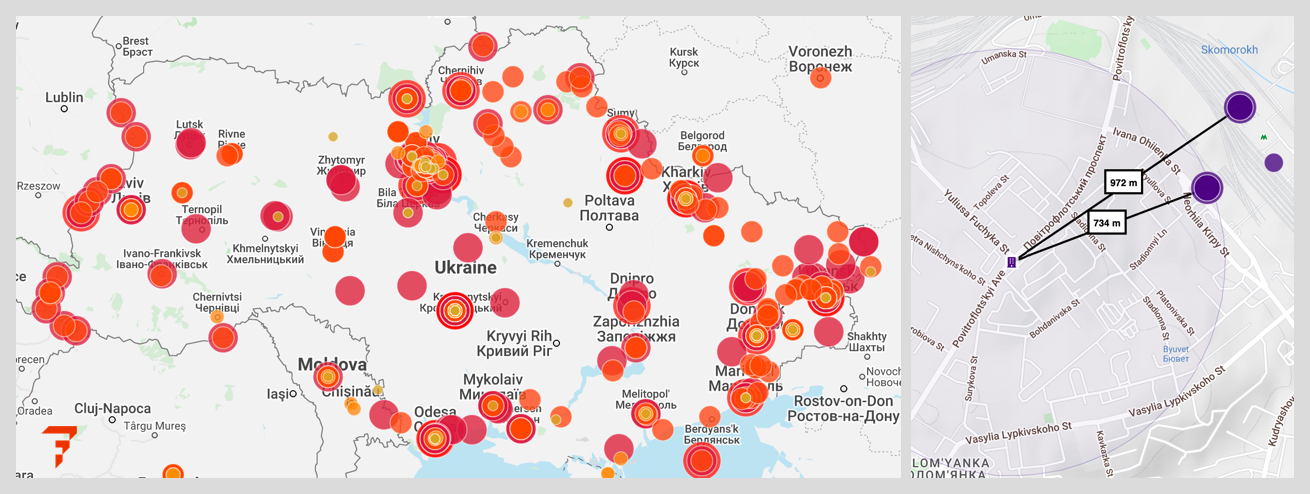The largest-scale military invasion in the modern internet era, Russia’s push into Ukraine set a new high-water mark for information warfare. While Russia focused on blatant deception and disruption, Ukraine’s government struggled to be transparent while trying to put a positive face on increasingly dire circumstances. Ukrainian citizens published a torrent of real-time reports that became the backbone of news coverage, but was occasionally clouded by the fog of war.
“We had to relearn on the fly how to process what quickly devolved into an information environment none of us had seen before,” explained Alex Moore, Factal’s Eastern European editor, who has covered the Russian-Ukraine conflict for several years.
Unlike other news organizations, Factal’s global newsroom verifies and geolocates specific events in real time, linking original sources. Many of the world’s largest companies and NGOs rely on Factal’s coverage and mapping to keep people safe and guide disaster response, often by triangulating real-time coverage with locations on the ground.
(More than 100 NGOs get Factal access for free. Apply here for free access. Companies can request a free trial here.)
When information is challenging to verify, Factal publishes “editor’s notes” to provide context about unverified details and conflicting sources. Along with Factal’s rapid coverage, editors notes have provided a critical advance notice for key moments of the invasion.
“We have personnel sheltering in Kyiv, and the geolocated alerts have been amazingly accurate in such a challenging environment.” – Factal member and Fortune 500 company
Factal had tracked the build-up to the invasion for weeks, sifting through Russia’s fake videos and other attempts to establish a pretext to war. Then on the night of February 24, our editors noticed a shift. Eastern Ukrainian social media sources suddenly went dark while Russian-aligned sources buzzed with anticipation.
“While the Donbass had historically been a conflict that was difficult to cover solely because of the sheer amount of information from both sides, it went to the opposite with the switch flip of Russian electronic warfare assets,” Moore said. “Telegram channels affiliated with Russian militias were jubilant, and that was where most of the chatter was the night of the invasion with communications dark throughout eastern Ukraine. They knew something big was coming and they didn’t hide it.”
Moore published an editor’s note (below) to give Factal members an advance notice on what was likely to come. A few hours later, President Putin announced “special military action” and cruise missiles struck Ukrainian targets.
Editor’s note: We are tracking an inordinate amount of unconfirmed chatter from pro-Russian Telegram sources in eastern Ukraine regarding the potential for Russian military action tonight. The sources are spreading a lot of unverified information, alleging that Russia has turned on electronic warfare platforms, spreading reports that phone service has been taken offline in Donetsk Oblast and claiming that 10 of Ukraine’s powerful Turkish Bayraktar drone have taken off. This comes as Russian state media reports that a large Ukrainian offensive has been launched in Luhansk region. The claims are difficult to verify at the moment as it does appear as though typical streams of information are being impacted amid the widespread reports of network outages. – Alex
As missile strikes and ground fighting began, Ukrainian citizens became the primary source of reliable information. Ukrainian media struggled under both physical and cyberattacks, and Western journalists in the country had limited ability to cover the news around them. Eyewitness reports became the window to the world.
“What many people don’t understand is that we Ukrainians are counting every gunshot, every artillery fire, every tank passing by,” explained Jane Lytvynenko, a disinformation researcher who was born in Ukraine. “On Telegram we exchange videos of neighbourhoods. For those of us lucky enough to be safe, we are getting information out. This is a mass mobilization.”
It’s that mass mobilization that made it difficult to doubt what’s happening on the ground. One video of Russian troops in a Ukrainian city may be difficult to verify in real time. But several videos of the same troops in the same city, taken from different angles at the same time, provides a much stronger case to corroborate the events. In fact, that’s how Factal was able to report Russian control of several Ukrainian cities ahead of official reports.
“In the face of Russian disinformation and attacks, telling our stories, the stories of our families and our people, telling them honestly and clearly, has become one of our best weapons,” Lytvynenko said.
Factal employs real-time verification to validate breaking news information with minimal lag time. This is similar but different from open source intelligence (OSINT), which focuses on imagery and research.
As of this writing, Factal has published several thousand verified updates and dozens of editor’s notes of the Russian invasion and its economic ripple effects around the world. But verification in a chaotic information environment is not a perfect science: Factal editors have also published three corrections.
“There’s a lot of propaganda and misinformation coming out of Ukraine and Russia. Factal editors are constantly weighing how newsworthy government claims compared to eyewitness reports, which are becoming less frequent,” said Jillian Stampher, Factal’s head of news. “What either side says matters, but we try to be as transparent as possible with who we’re sourcing and why.”
As the war and humanitarian crisis deepen, Russia is redrawing Cold War lines in a high-tech information world. The Kremlin has shut down independent news organizations, forced Western journalists to leave, criminalized “fake news” and blocked social platforms. Russian citizens are cut off from the rest of the world and isolated from the truth. As the Committee to Protect Journalists described it, “Putin has plunged Russia into an information dark age.”
(Cory Bergman is the co-founder of Factal and a longtime journalist. Visit Factal.com to learn more about Factal’s services and how to start a free trial. Qualified NGOs get Factal access for free. Top image shows several days of Factal’s Ukraine coverage and an example of proximity to an event.)

